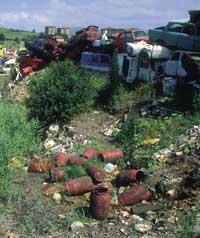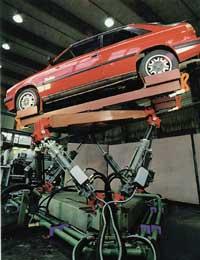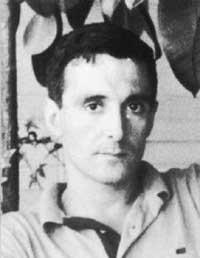Industrial waste management plans in Hego Euskal Herria
1997/07/01 Etxaide, Maider Iturria: Elhuyar aldizkaria
Hazardous Waste Strategy in Spain
The State Hazardous Waste Plan was approved in 1995, with socialists in full control. Its main objectives, according to what the European Association proposed, were to reduce, recycle and recover hazardous waste by the year 2000. In the same way that European laws attributed waste management to each of the States, the Spanish Plan attributed this obligation to each Autonomous Community.
The minimum reduction established by the State Plan was 40%, not a rare figure! In addition, the concept of reduction was widely interpreted, since it considered prevention as a basic and essential means to reduce waste. The Plan also noted the intention of implementing specific programmes for the achievement of the objectives. Another notable point or criterion of the proposal was that incineration was not necessary for the treatment of waste. Instead, in order to be able to give a controlled solution to residues that currently have no treatment, it boosted storage as a final treatment. Likewise, it required all Autonomous Associations to present to the State their inventories and plans within a year. Therefore, being this very saving plan, the ecologists gave it for good, even if they did not agree with all their sections.
No inventory or prevention
Unfortunately, and as it usually happens, things have not been done as planned in the plan. After two years, the situation is as follows: on the one hand, the majority of the autonomous associations have not completed this period, including Navarre, and on the other hand, everything proposed from the preventive point of view has not been able to advance. Consequently, in most cases the inventory is missing, that is, the instruments necessary to carry out the plans. The funding proposed for prevention, for a planned amount of 2.3 billion pesetas in 1996, is another point that has not been met. To Andalusia, for example, they corresponded 500 million pesetas and only 36 have been granted. Instead of investing most of the money in prevention, it has been used to build infrastructures. In the controversial warehouse of toxic waste of Nervión-Huelva, controversial for the lack of elaboration of the Andalusia Plan and for the failure to comply with the environmental conditions of the cell, 300 million pesetas have been invested this year.
After the 1996 government change, it can be suspected that things will get worse. The general waste law is currently being developed. Although this law will allow for the joint regulation of all types of waste (a matter that has so far been dispersed by different laws), the way to designate some of the waste treatments proposed in it is ambiguous and, therefore, there is a great risk of reading harmful to the environment. For example, when the terms “valorization” or “elimination” are used, this law means incineration and not another. On the other hand, the definition of prevention and the hierarchy of priorities that appeared in the previous plan is not respected (prevention 1, reuse 2, recycling 3, treatment 4).
Valorization: trap of terms

This word arises by theorizing about recycling in relation to thermal use. In community directives, valorization is quite important and is being sold as an ecological way, but what is intended is to promote incineration. In some places it is also used as synonymous of recycling. In order to clarify the confusion around the following terms, a definition of cardiac recycling and valorization is the reuse of the material as the reuse of scrap as raw material for the metal industry, while the valorization consists of burning and using the resulting energy for the productive processes or for the production of electricity.
Special Waste Management Plan in the CAPV
This is one of the first plans to be carried out at the state level, together with Catalan. It requires a well-made inventory and close to reality. According to this inventory, 538.000 tons of special waste are generated annually in the CAPV. Of these, 28% were not managed at the time of the study, that is, had an unknown goal. The objectives of the Plan are based on European criteria for prevention, reduction and recycling. In spite of the clear formulation of these paper objectives, in practice, the creation of waste treatment infrastructures such as drills, solvents and the so-called Advanced Centre for Recycling of oils has been resorted to. The objective of the Plan for 1996 was to reduce waste by 25%, but to date it has only been reduced by 13%. It is evident that these figures are relatively far from the objectives of the State Plan (40% for the year 2000), so it is necessary to review the Basque Plan. On the other hand, it is not clear whether this threshold of reduction is intended to be achieved as a consequence of preventive policy (in the previous article we said that prevention is based on the use of clean technologies) or by promoting good practices in companies.
In any case, and despite the dark points in the implementation of the plan, the hazardous waste policy of the Basque Government is quite distorted with respect to other autonomous associations.
The Navarre Plan... Or not?
Four years have passed discussing the Plan in Navarre. Two years ago the first draft was drafted and at present it has not been definitively approved by Parliament. It was a topic that was poorly raised since its origin, since the need to draft the Plan was raised with the project of the underground cell of Potasas de Navarra. The warehouse provoked a strong controversy, so the project was suspended and for the moment the Plan.
This Plan is written in the same terms as the State Plan (1996-2000). Its highlight is the inventory. This means the production of 54.000 tons of special waste, but its reliability is very doubtful. The objectives proposed are: Reduction of 21% and recycling/valorization 18%. These figures are far from those proposed by the state strategy and, in addition, the failure to implement any project will further remove these objectives. Two years ago the Basque and Navarrese governments signed a collaboration agreement on toxic waste, which has not advanced.

Gai honi buruzko eduki gehiago
Elhuyarrek garatutako teknologia





